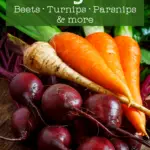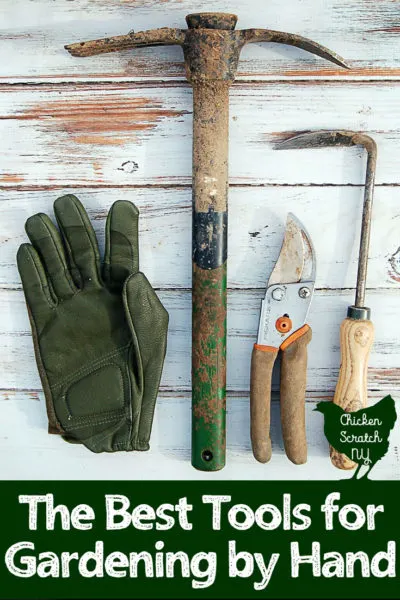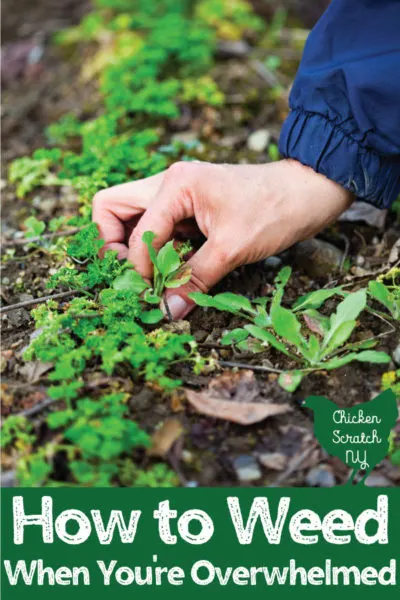Root vegetables are often expensive to buy but easy to grow. It’s a large category that covers many delicious flavors, shapes, and colors but they’re generally grown the same way.
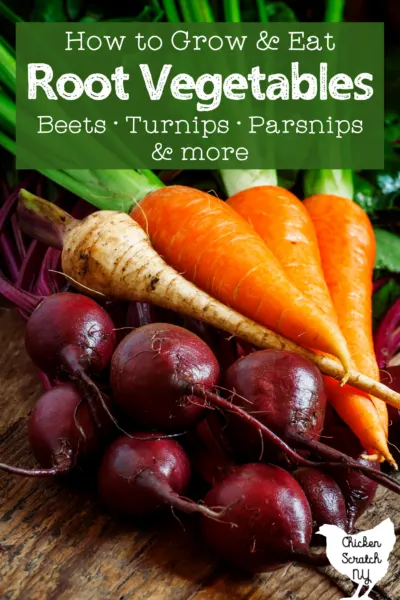
The phrase “root vegetables” doesn’t refer to a specific family or species of vegetable plants. Instead, the term is used to describe any vegetable that is grown for its enlarged roots.
Since we’re after the roots, these crops are all one and done, unlike a bean or tomato plant where you can keep picking to keep the harvest going, when you pull a carrot that’s it for that plant.
You’ll need to plant one seed for every single root vegetable you plan to harvest, so don’t be surprised when you got to buy your seeds and see hundreds or even thousands of seeds in a packet.
Read more about Ordering Seeds
One thing all the root vegetables have in common is a sweet flavor. The roots are basically plant storage tanks for sugar, that sweetness can be brought out by roasting to caramelize the natural sugars.
Most root vegetables can pull double duty in the garden, offering up delicious edible greens along with the roots, the exception is parsnips greens, don’t eat those. For a real fresh-from-the-garden treat try cooking up the fresh roots and greens together!
Some root crops, like radishes, are even grown as cover crops, the strong and deep growing roots break up compacted soil while the foliage shades out the competition. You can also use root vegetables as forage crops for livestock.
Potatoes and sweet potatoes are tubers, which are technically enlarged roots but I’ve left them off this list because they’re grown differently and you don’t have that one to one ratio where one plant equals one root vegetable. One potato plant will provide you with lots of potato tubers.
Read more about Cover Crops
How to Grow Root Vegetables
All root vegetables will perform their best in deep, loose soil. Even the shorter, ball-shaped crops like beets and turnips will send down a long taproot that can reach three or more feet in length.
Root vegetables will also do best if they are directly seeded into the garden. In general, plants with taproots don’t like having their roots disturbed and transplanting will cause unnecessary stress on the baby plants.
If possible start planning for your root vegetable crops in the fall. Work compost into the soil and cover it with a thick layer of chopped up leaves. The mulch will insulate the soil and encourage earthworms to do their magic.
Check your seed packets for seeding dates, the hardier root vegetables can be started in cooler soil before the last frost date. Carrots prefer warmer soil for germination and should be planted after your last frost date, around the time you’d plant tomatoes.
The quick-growing root crops (beets, turnips & radishes) are often grown in succession, with an initial planting followed by more seedings in 10-14 day intervals. Doing this will provide you with a consistent harvest of vegetables over time.
Prepare your seed bed by raking it smooth, this will allow the small seeds to have good contact with the soil. Seed according to the depth and spacing recommendations on the packet.
Water well and watch for germination. The long-growing root crops, parsnips and rutabagas can be mulched with chopped leaves and a thick layer of straw and then ignored more the rest of the season.
Different Types of Root Vegetables
While the basic steps for planting and growing root vegetables are the same there are some differences and thing to look out for for each variety.
I’ve added a recipe for easy roasted root vegetables at the end (it’s not really a recipe, more of a cooking method) but I’ve added links to a few recipes starring each type of root vegetable.
Carrots
Carrots are the most popular root vegetable and the one you’re most likely to find in the store. Of course, carrots grown at home are tastier and so much more fun.
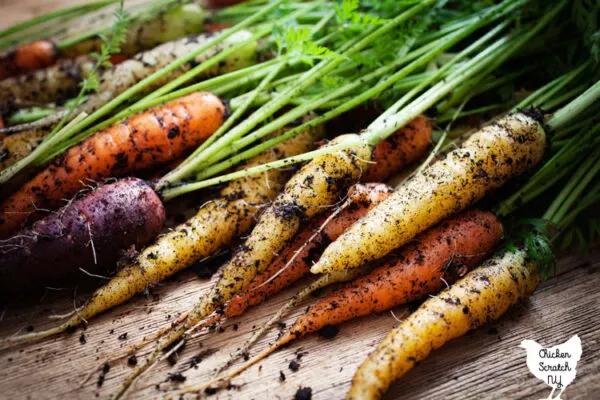
One of the hardest things about growing carrots is getting the spacing right, the tiny seeds tend to go everywhere. You can make your own seed tape or but seeds that are encapsulted in clay for more control.
Personally I just deal with it and thin them as needed, carrot seeds usually come in giant packets and I’m never going to plant them all any way.
Another stumbling block with carrots is the germination, even at optimal soil temperatures (around 75 degrees), they can take a week to come up. It’s critical that the seeds stay moist during that entire week.
I’ve seen it reccomended that you cover the seeds with burlap to hold in the moisture while they’re germinating. Just be sure to check on it and remove it when you see the carrot seedlings coming up.
Carrot Varieties
Carrots will grow best in loose soil but if you’re looking for carrots to grow in heavy, clay soil look for short, stubby round carrots. They still offer up carrot flavor with they’ll do much better in your soil than the longer traditional carrots. I’ve grown Tonda di Parigi carrots and not only did they grow well in my clay soil, but my kids also loved them!
There are a lot of traditional carrot varieties out there, but my goal in the garden is to grow things I can’t easily get in stores and I love planting weird colored food. One of my favorite seed mixes is the Carnival Blend carrot seeds from Botanical interests, it has red, purple, white, yellow, and orange carrots all mixed together.
Carrot Recipes
- Roasted Carrots with Carrot Top Pesto
- Moroccan Carrot Soup
- Classic Carrot Cake with Cream Cheese Frosting
Parsnips
Parsnips are overlooked and unfortunately tend to be expensive. In fact the carrot relatives look a lot like pale, overgrown, sad carrots.
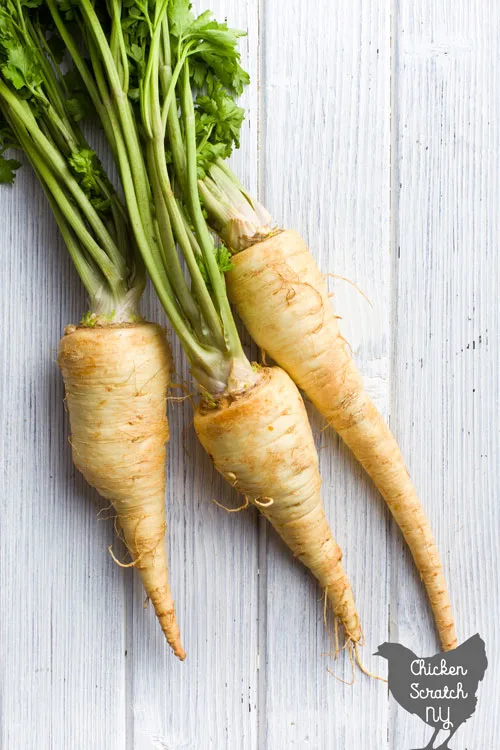
They take even longer than carrots to germinate, it can take up to 3 weeks for the seedlings to emerge. I’ve had the best luck covering my seeds with a thin layer of seed starting mix, it doesn’t crust over like soil can and it allows the delicate and dainty seedlings to come up without a struggle.
Parsnips are an odd ball in the garden, they take quite a bit of effort to get going but then they’re pretty hands off until you harvest them. They are a full season investement, going in the round before your last frost date and remaining there until after a few frosts.
Unlike a lot of plants parsnips are actually improved by frost, the cool temperatures convert starch in the roots into the sugars that give them their sweet, nutty flavor. They can even be stored in the garden, assuming the ground isn’t covered by a few feet of snow you can keep harvesting them fresh well into winter.
Parsnips and carrots are biennials, meaning their life cycle is completed in two years. The first year they grow a large root and the second year they bolt, or go to seed. If you leave your parsnips in the ground all winter, when the warm weather comes they will send up a flower stalk and go to seed.
Parsnip seed is known for having a very small viability window and it’s recommended that you purchase new parsnip seeds every year.
One really important thing to know about parsnips is that the leaves can cause Phytophotodermatitis, or parsnip rash. It happens when you get the oils from the plant leaves on your skin and then they are exposed to the sun.
The best prevention is to wear gloves, long sleeves, and long plants when working in the parsnip patch. If you keep your parsnips well mulched they won’t require much upkeep through the growing season. Common Sense Home has a lot of information on Parsnip Rash.
Parsnip Recipes
Beets
Beets get a lot of hate for tasting “like dirt” but I’ve been obsessed with them since I was a kid and used to steal them from my grandpas garden. I’ll eat an entire jar of pickled beets on my own but they really shine when roasted and eaten warm with a little bit of salted butter.
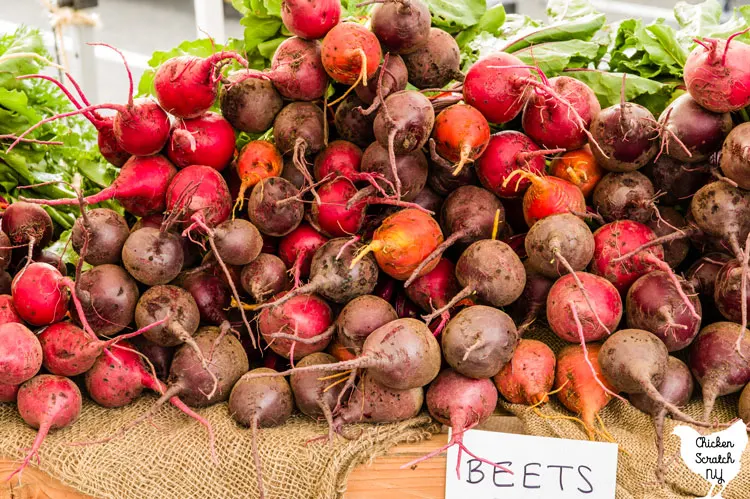
Swiss chard and spinach are the only close beet relative grown in the vegetable garden so they are easy to fit into a crop rotation plan. The family resemblance is clear when you look at the seed capsules for each plant.
Beet and swiss chard seeds aren’t individual seeds, instead, they are small clusters of seeds. That can make spacing hard but if you enjoy eating baby beets just let the little plants grow together and harvest them as a clump, they won’t be perfectly round but they’ll taste just as good.
Baby beets (about golf ball size) are basically garden fast food, they can be ready to harvest in 40 days. You can let them grow larger but the general consensus is beets taste best when small so try to harvest them below 4 inches in diameter.
Beets are a cool-season root vegetable, they don’t enjoy the heat and will struggle during the hot summers. Take a break in your succession planting during the hottest months and then resume in the late summer where you can keep growing beets as long as you harvest before the first heavy frost. Of course you can go even longer if you use floating row covers.
Interested in winter gardening? Check out The Winter Harvest Handbook by Elliot Coleman
Beet Varieties
If gardeners are good at anything it’s growing and breeding plants for specific purposes. And beets are an amazing example of how specific plant breeding can be.
You can grow long, relatively thin beets perfect for slicing and pickling like Cylindra. Or grow beets like Early Wonder Tall Top that were bred specifically for their extra tall and delicious beet greens.
Other than that straight-up lie about dirt flavor the other huge complaint about beets is the bleeding problem. The beets won’t make you bleed (side note, if you eat a lot of beets and go to the bathroom you might think you’re internally bleeding and dying, you’re not, it’s just the beets) but the red roots and even the beet green will leave red stains everywhere.
But there are beets to solve that problem too! You can grow white beets, golden beets, and even red and white ringed Chioggia beets if you prefer your food resemble a bullseye. Or go crazy and plant them all in a Gourmet beet mix.
Beet Recipes
Turnips
The final three root vegetables on this list are all in the Brassica or cabbage family. If you thought beet specialization was nuts you’ll lose your mind when you dig into all the crazy things we’ve done with mustard!
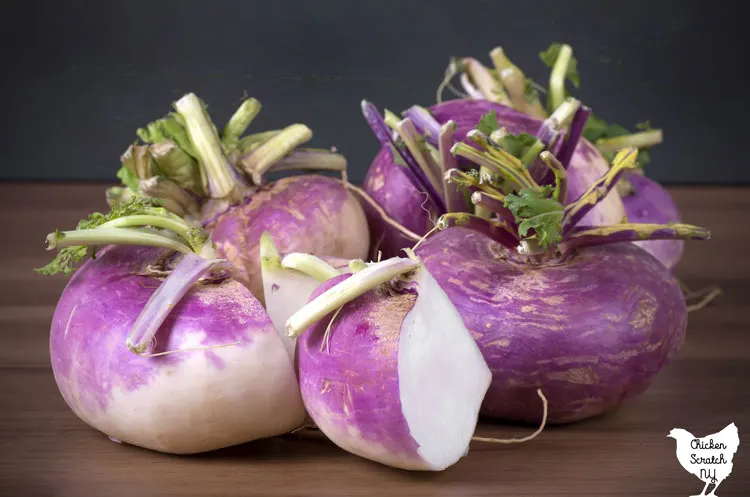
First up are turnips, just like parsnips these little guys are overlooked and it’s a real shame.
Turnips are a quick-growing, cool-season root vegetable. They can be planted up to a month before your last frost date in the spring and can be harvested after 30 days if you’re looking for baby turnips or 10 days later for full-sized roots.
I’ll admit they aren’t much to look at, you can grow all white turnips or purple top turnips where the shoulders that sit above the soil develop a purple color.
Like beets, turnips green and roots are edible and they’re best eaten when small. When turnips get large the white roots get a strong and unpleasant flavor.
In the kitchen turnips can be treated a lot like potatoes, you can boil ’em, mash ’em or stick ’em in a stew.
Read more about Why Your Growing Zone Doesn’t Matter in the Vegetable Garden
Turnip Recipes
Radishes
Radishes are the best example of “do as I say, not as I do” in the vegetable garden. One of my ‘gardening rules’ is to only plant things you like to eat.
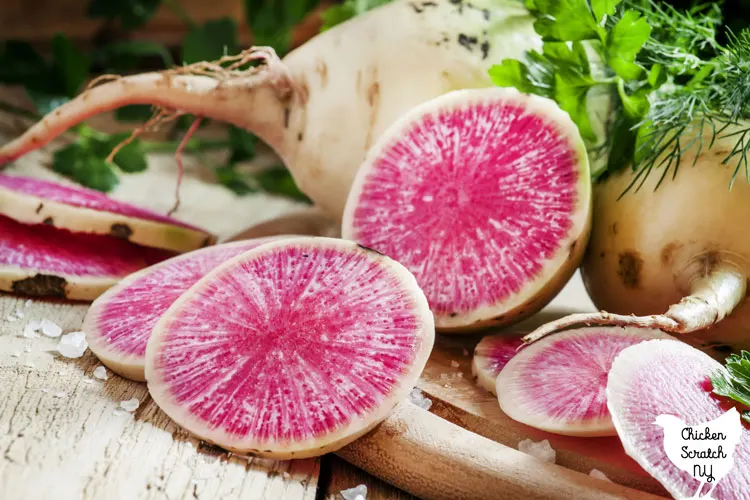
However, I’m not really a radish fan. I grow them for other reasons then then feed them to the chickens or my brother-in-law.
Overwhelmed with garden planning? Here are my best tips to help you know What Should You Grow in Your Vegetable Garden
Radishes are the number one garden fast food, they grow so quickly it’s hard to believe you can’t see them moving. Spring radishes go from seed to harvest in about 25-30 days and if you want too much longer they’ll have already gone to seed.
Just like beets and turnips, you want to harvest these guys small and you can eat the whole plant from root to leaves.
Out of all the root vegetables on this list radishes are the hardest to fail with. I’m sure they’d love to be babied but they’ll perform in hard, compacted soil and are even a great option for a cover crop that breaks up your soil, improving it for later crops.
Radish Varieties
There are two types of radishes, the spring/summer radishes and the winter radishes.
The spring radishes are the really fast-growing, small peppery root veggies your grandma ate all the time (maybe that was just me?). You can find some fun varieties, like Easter Egg Radishes where they grow in different colors and you don’t know what they’ll be until you pull them up, or the elongated French Breakfast Radish that has been grown for more than 100 years.
Winter radishes take a longer time to mature, 50-60 days and they should be sown in 8-10 weeks before your first frost date in the fall. These radishes require shortening daylight to trigger root growth. Popular winter radishes are the Watermelon radish that resembles a watermelon when cut and Daikon radishes.
Radish Recipes
Learn more about Growing Radishes and 5 Reasons you Need them in your Garden
Rutabagas
The last brassica on out list is the oh-so-ugly rutabaga. I think these guys have a bad reputation like turnips of being old fashioned grandma food. When you buy them in stores they’re usually coated in a thick layer of wax to hold in the moisture and keep them fresh.
Rutabagas (or swedes in the UK) are often confused with turnips (they’re even called turnips in Scotland) but they are two distinct root vegetables. When you cut them open you’ll notice rutabagas have yellow flesh while turnips are white inside.
Rutabagas are larger than turnips and take longer to mature, around 60 days vs 30-40 for turnips. Just like turnips and beets, they have edible greens.
Growing rutabagas prefer cooler weather and they are often grown as a fall crop so they can mature in fall months. Rutabaga seeds won’t germinate if the soil is too warm which can be an issue when seeding in the late summer, try shading the area if you are having trouble with germination.
The roots are best when harvested after a few hard frosts. And they can be stored for months in the root cellar or in a plastic bag in the crisper drawer in the fridge.
Rutabaga Recipes
Other Root Vegetables
If you’re like me and you can’t get enough of the odd ball vegetables you’re in luck because there are even more root veggies for you to grow. The following root crops are less common and there might even be a few you’ve never heard of!
Celeriac
Celeriac is also called root celery, it’s related to celery and has a similar flavor but it’s grown for its enlarged roots.
Every rule has an exception and celeriac is the exception to the ‘don’t start root crops indoors’ rule. Celeriac seeds should be started indoors about 10 weeks before your last frost date, like celery these plants are slow-growing and require a lot of water.
Celeriac Recipe: Celeriac Soup
Horseradish
You don’t grow horseradish, you plant it once and spend the rest of your life trying to keep it from taking over. Horseradish is grown from root division and should be planted somewhere you can easily mow around it to keep it in check.
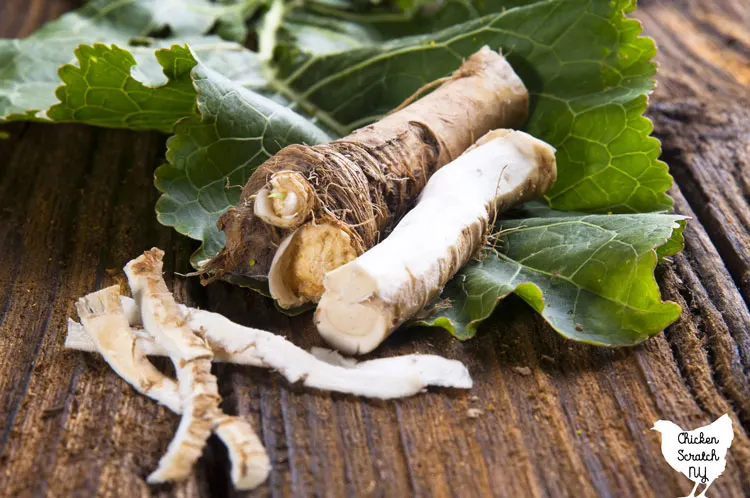
Horseradish has a flavor just as strong as its will to live and you only need a small amount to flavor a dish. I would also recommend you NEVER put it in the food processor to chop it up unless you’d like to experience chemical warfare in your kitchen.
Horseradish recipe: Fresh Horseradish Sauce with Beets
Root Parsley
Root parsley is a specific variety of parsley developed for large roots. The roots resemble large, white carrots and have a flavor described as a sweet mix of parsley and celery.
The roots can reach a foot in length and should be grown deep, loose soil. The can be treated like carrots in the garden and the leave can be used like regular parsley.
Root Parsley Recipe: Parsley Root Fries
Salsify or Oyster Plant
Here we have another root that looks like a parsnip and this one is grown like a parsnip (right known to the slow germination and dislike for competition) but this guy is in the Sunflower family and not the carrot family.
Salsify seed takes up to 3 weeks to germinate and 4 months to mature. It can be cooked and eaten in soups, stews, or roasted.
Salsify Recipe: Salsify Gratin
Storing Root Vegetables
Root vegetables grown and harvested in the fall and early winter can be kept as storage crops through the winter. Select unblemished or undamaged vegetables for storage so they don’t rot and ruin the rest of the crop.
Beets, carrots, turnips, rutabagas, and parsnips can be stored in damp sand in a cool space like a root cellar or an unheated basement. For best results, the area should be between 35 and 38 degrees.
You can use regular play sand to store your veggies, make sure you wash everything well before eating. Don’t wash the vegetables before buying them in the sand, just brush off the dirt and remove the greens.
Root veggies can also be stores in the ground for varying amounts of time. Lovely Greens has an amazing breakdown of how to store different root vegetables in the ground.
Interested in learning more about long-term food storage? Check out Root Cellaring by Mike & Nacy Bubel
Easy Roasted Root Vegetables
I’m a lazy gardener and an even lazier cook. I love to make simple food with few ingredients that doesn’t require a recipe.
Roasted root vegetables make a great side dish but I’m way more likely to just eat it on it’s own with some butter.
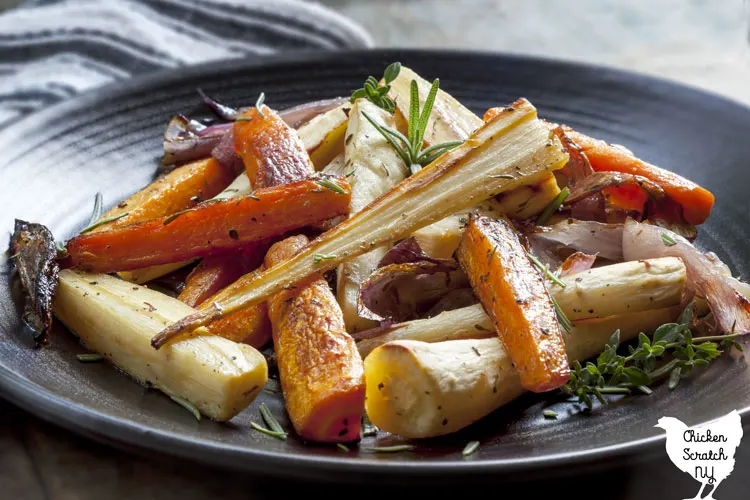
All you need to make easy roasted root vegetables is a heavy pan, some oil or fat, and your vegetables. Start by preheating the oven to 425 degrees F.
You can use any combination or rot vegetables, you can even throw in some chunks of potato, sweet potato, onion or garlic.
Scrub the dirt from your root vegetables, peel them, and cut them into similar-sized chunks or slices so everything cook evenly.
Put them in a bowl with a glug of olive oil or some melted bacon fat and give them a toss so everything is coated.
Spread out in a single layer on a baking sheet or roasting pan, I love to use my cast iron pizza pan for this. Sprinkle with some salt and roast for 25-45 minutes (it will depend on the size of your veggies) or until tender.
Remove from the oven and let them cool just enough so you won’t burn your mouth when you eat them. Serve with butter or maple syrup or both.
Check out my Vegetable Garden page for more ideas or start here:

